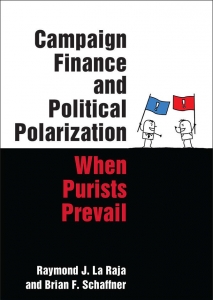Book Review: Campaign Finance and Political Polarization: When Purists Prevail by Raymond J. La Raja and Brian F. Schaffner
Is there too much money behind US political campaigns or is it more a question of where the money flows? In Campaign Finance and Political Polarization: When Purists Prevail, Raymond J. La Raja and Brian F. Schaffner present their argument in favour of giving more, rather than less, money to political parties in order to reduce the polarisation that characterises the US political system. While she questions the extrapolation of state-level analysis to the federal level, Melissa M. Smith praises the cogent delivery of the book’s central claim, even if it remains to be seen if the authors’ points will make it into practice.
If you are interested in this review, you may also like to read an article by the book’s authors, La Raja and Schaffner, published on LSE USA Politics and Policy blog.
Campaign Finance and Political Polarization: When Purists Prevail. Raymond J. La Raja and Brian F. Schaffner. University of Michigan Press. 2015.
 Let’s face it. Campaign finance isn’t a sexy topic. It’s one that the US public says needs to be addressed, but those same people who profess to be worked up over the issue really know very little about the existing rules, where the money comes from or where it goes. There just seems to be a general sense that there is too much money in politics.
Let’s face it. Campaign finance isn’t a sexy topic. It’s one that the US public says needs to be addressed, but those same people who profess to be worked up over the issue really know very little about the existing rules, where the money comes from or where it goes. There just seems to be a general sense that there is too much money in politics.
Raymond J. La Raja and Brian F. Schaffner do not seem bothered by the amount of money going into US elections. Their argument is to shift more money to the political parties and thereby reduce the polarisation in US politics. They make the argument in an interesting way – by comparing data from all fifty states, rather than by looking at the federal policies and their effects on elections. The reason for this is that finance laws can differ greatly from state to state, thereby providing insight into what happens when different rules are applied. The authors compare states with strict limits on money given to political parties with those that have few or no limits on what parties can raise. Their findings show that in states where there are no constraints on what can be collected, parties raise more than twice as much as in states where limits have been put in place. This money is then spent to help support more moderate candidates. They theorise that this is what could also happen at the national level.
But why does this matter? The authors spend much of the first chapter looking at theories about political parties and how they function. They divide the groups that vie for political party power into the ‘pragmatists’ and the ‘purists’. Pragmatists are party stalwarts who are concerned with winning elections and gaining power. They tend to favour more moderate candidates. Purists are more ideologically-oriented and tend to operate outside the party structure. According to the authors, purists draw electoral candidates away from the centre — more moderate views — towards either end of the political spectrum. This is because purists are looking to support candidates who agree with their particular issues, rather than whether these candidates are electable. Pragmatists, however, tend to support more moderate candidates whose messages have more appeal for a broader range of voters.
The current campaign finance system that is in place is what the authors term ‘candidate centered’. This means that party funding is restricted, so candidates rely more on money and support from interest groups and activist donors — the purists. For instance, in the 2016 presidential election, some Republican candidates ‘auditioned’ for wealthy donors in the hope that they would gain financial support from the Super PACs set up by these affluent individuals. The authors would look at this and say that it is a consequence of having finance rules that favour these types of interest groups rather than political parties. These wealthy individuals are usually looking for candidates who will support specific issues, and most of the time those issues will pull a candidate towards the political left or right. The authors contend that this adds to the political polarisation in the USA, and that it can be countered by changing finance rules to favour parties instead of candidates.
La Raja and Schaffner go to great lengths to explain their positions and buttress their arguments. They include charts, advanced statistical analysis and much comparison of data. They state and re-state their premises so often that it becomes a bit repetitive. However, there is good reason for this. They realise that what they are saying is controversial. The US public doesn’t seem to trust political parties, and the elected officials who make campaign finance laws are the ones who are benefitting from the current system.
The authors make a strong argument that changing the flow of money would reduce the binary that currently exists. They are careful to say that this is one of the factors contributing to polarisation, but that it is likely not to be the only one. They propose four basic rules to change to a party-centered campaign finance system: a) Limits on contributions to political parties should be relatively high or nonexistent; b) Contributions to candidates from outside groups and individuals should be trimmed back to prevent interest groups and ideological donors from continuing to excessively influence the process; c) No restrictions should be imposed on party support of candidates; and d) Public financing should support party organisations.
It is easy to see that any of these four suggestions will be controversial. While political parties might like these rules, interest groups and outside donors will not, and many people will take issue with the public financing of parties, whatever form this might take. Anticipating this, the authors even include two possible objections to their proposals and outline their responses. La Raja and Schaffner also realise that they are proposing that findings from the state level be extrapolated to the federal level, and although the authors are optimistic, there is no evidence that this would actually shift the political atmosphere to one that is less polarised.
Perhaps another question that should be considered by the authors is this: do enough people actually want to change the system? There are people for whom ideological issues are paramount, and they would not want to surrender more control to a party structure. Others simply have grown accustomed to the current polarised system, which limits the amount of legislation that is approved at the federal level. Among some Americans, there is the thought that gridlock isn’t entirely bad as it keeps the government from taking actions that might negatively impact their lives.
The authors have done a very nice job of making their arguments. They meticulously analyse party factions, who donates to political campaigns and why, and they also examine data that indicate how fewer restrictions on political parties increase financial support for moderate candidates. Anyone interested in looking at an alternative to the current campaign finance system should read this research. Whether it will actually contribute to a change in the system, however, remains to be seen.
—
Note: this post originally appeared on the LSE Review of Books. It represents the views of the author and not those of Democratic Audit or the LSE. Please read our comments policy before posting.
—
Melissa M. Smith is an Assistant Professor in the Department of Communication at Mississippi University for Women. Her research focuses on US elections, particularly campaign finance reform. Her work has appeared in several journals, and she is the co-author of two books, Campaign Finance Reform: The Political Shell Game and Dark Money, Super PACs, and the 2012 Election, both published by Lexington Books.






 Democratic Audit's core funding is provided by the Joseph Rowntree Charitable Trust. Additional funding is provided by the London School of Economics.
Democratic Audit's core funding is provided by the Joseph Rowntree Charitable Trust. Additional funding is provided by the London School of Economics.
Melissa M. Smith reviews ‘Campaign Finance & Political Polarization: When Purists Prevail’ https://t.co/k84mIA9WPQ https://t.co/AeNyIQkuQz
Review: Campaign Finance & Political Polarization: When Purists Prevail by Raymond J. La Raja & Brian F. Schaffner https://t.co/v8i7WfrdiU
Book Review: Campaign Finance & Political Polarization: When Purists Prevail by Raymond La Raja & Brian F. Schaffner https://t.co/0ci6UjFApy
Book Review: Campaign Finance and Political Polarization: When Purists Prevail by Raymond… https://t.co/iLLpJ1r2Lu https://t.co/OpgSj2zuTd
Book Review: Campaign Finance and Political Polarization: When Purists Prevail by Raymond La Raja & Brian Schaffner https://t.co/0ci6UjFApy